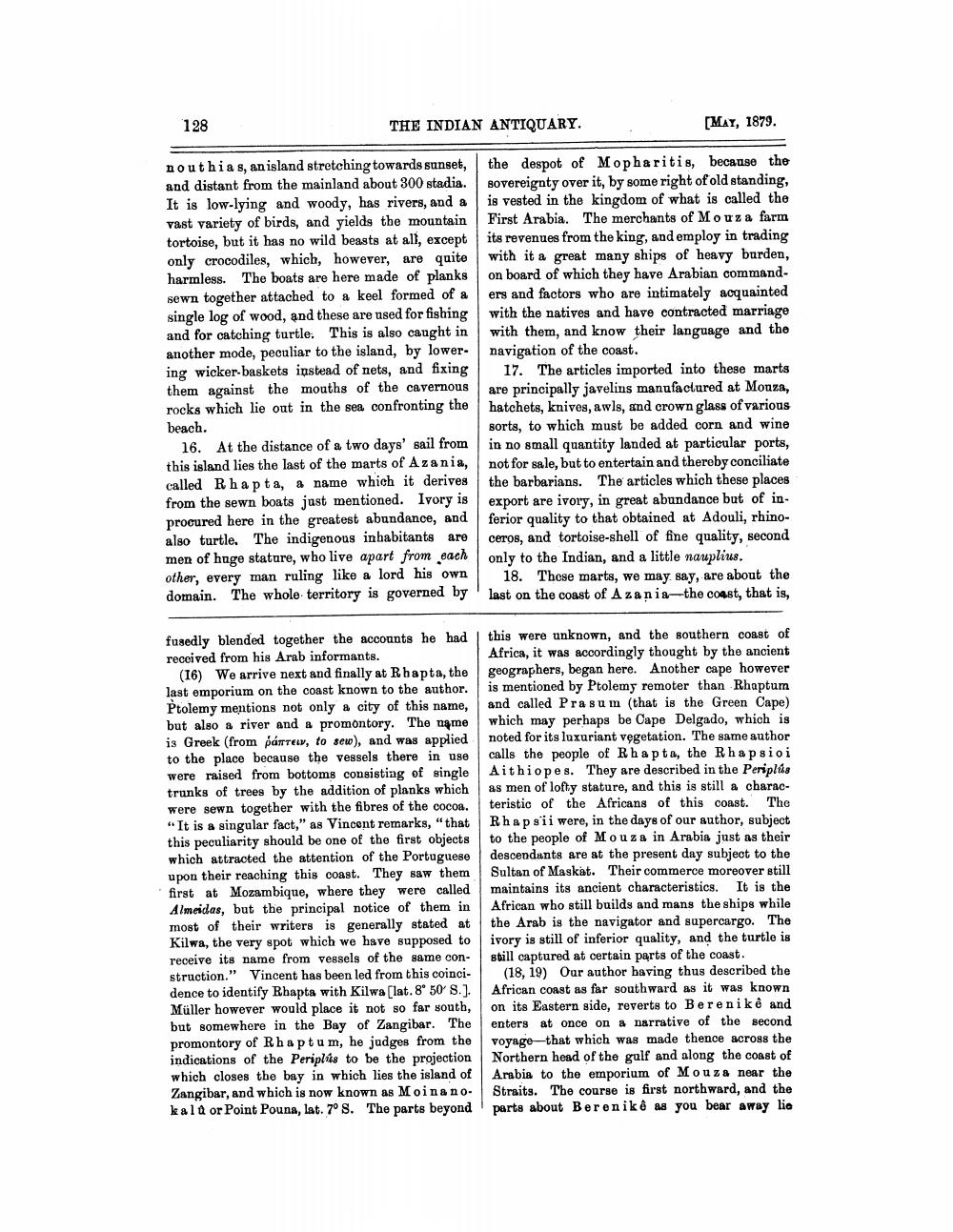________________
128
THE INDIAN ANTIQUARY.
[MAY, 1879.
nouthias, an island stretching towards sunset, and distant from the mainland about 300 stadia. It is low-lying and woody, has rivers, and a vast variety of birds, and yields the mountain tortoise, but it has no wild beasts at all, except only crocodiles, which, however, are quite harmless. The boats are here made of planks sewn together attached to a keel formed of a single log of wood, and these are used for fishing and for catching turtle. This is also caught in another mode, peculiar to the island, by lower ing wicker baskets instead of nets, and fixing them against the mouths of the cavernous rocks which lie out in the sea confronting the beach.
16. At the distance of a two days' sail from this island lies the last of the marts of Azania, called Rhapta, & name which it derives from the sewn boats just mentioned. Ivory is procured here in the greatest abundance, and also turtle. The indigenous inhabitants are men of huge stature, who live apart from each other, every man ruling like a lord his own domain. The whole territory is governed by
the despot of Mopharitis, because the sovereignty over it, by some right of old standing, is vested in the kingdom of what is called the First Arabia. The merchants of Mouza farm its revenues from the king, and employ in trading with it a great many ships of heavy burden, on board of which they have Arabian commanders and factors who are intimately acquainted with the natives and have contracted marriage with them, and know their language and tho navigation of the coast.
17. The articles imported into these marts are principally javelins manufactured at Mouza, hatchets, knives, awls, and crown glass of various sorts, to which must be added corn and wine in no small quantity landed at particular ports, not for sale, but to entertain and thereby conciliate the barbarians. The articles which these places export are ivory, in great abundance but of in. ferior quality to that obtained at Adouli, rhinoceros, and tortoise-shell of fine quality, second only to the Indian, and a little nauplius.
18. These marts, we may say, are about the last on the coast of Azania--the coast, that is,
fusedly blended together the accounts he had received from his Arab informants.
(16) We arrive next and finally at Rhapta, the last emporium on the coast known to the author. Ptolemy mentions not only a city of this name, but also a river and a promontory. The name is Greek (from PárteLv, to sew), and was applied to the place because the vessels there in use were raised from bottoms consisting of single trunks of trees by the addition of planks which were sewn together with the fibres of the cocoa. "It is a singular fact," as Vincent remarks, "that this peculiarity should be one of the first objects which attracted the attention of the Portuguese upon their reaching this coast. They saw them first at Mozambique, where they were called Almeidas, but the principal notice of them in most of their writers is generally stated at Kilwa, the very spot which we have supposed to receive its name from vessels of the same construction." Vincent has been led from this coincidence to identify Rhapta with Kilwa (lat. 8* 50 S.). Müller however would place it not so far south, but somewhere in the Bay of Zangibar. The promontory of Rh&ptum, he judges from the indications of the Periplús to be the projection which closes the bay in which lies the island of Zangibar, and which is now known as Moina no. kald or Point Pouna, lat. 7o8. The parts beyond
this were unknown, and the southern coast of Africa, it was accordingly thought by the ancient geographers, began here. Another cape however is mentioned by Ptolemy remoter than Rhaptum and called Prasum (that is the Green Cape) which may perhaps be Cape Delgado, which is noted for its luxuriant vegetation. The same author calls the people of Rhapta, the Rhapsioi Aithiopes. They are described in the Periplas as men of lofty stature, and this is still a characteristic of the Africans of this coast. The Rhapsii were, in the days of our author, subject to the people of Mouza in Arabia just as their descendants are at the present day subject to the Sultan of Maskat. Their commerce moreover still maintains its ancient characteristics. It is the African who still builds and mans the ships while the Arab is the navigator and supercargo. The ivory is still of inferior quality, and the turtle is still captured at certain parts of the coast.
(18, 19) Our author having thus described the African coast as far southward as it was known on its Eastern side, reverts to Berenike and enters at once on a narrative of the second voyage that which was made thence across the Northern head of the gulf and along the coast of Arabia to the emporium of Mouza near the Straits. The course is first northward, and the parts about Berenikê as you bear away lie




